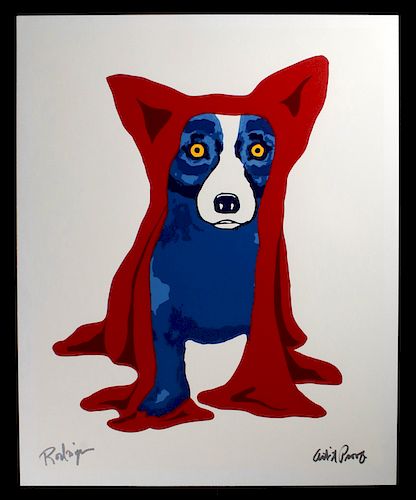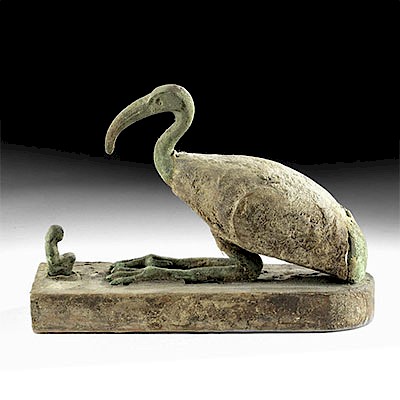Blue Dog w/ Red Cloak, Rodrigue Signed Artist's Proof
Lot 287
About Seller
Artemis Fine Arts
686 S Taylor Ave, Ste 106
Louisville, CO 80027
United States
Selling antiquities, ancient and ethnographic art online since 1993, Artemis Gallery specializes in Classical Antiquities (Egyptian, Greek, Roman, Near Eastern), Asian, Pre-Columbian, African / Tribal / Oceanographic art. Our extensive inventory includes pottery, stone, metal, wood, glass and textil...Read more
Estimate:
$4,000 - $6,000
Absentee vs Live bid
Two ways to bid:
- Leave a max absentee bid and the platform will bid on your behalf up to your maximum bid during the live auction.
- Bid live during the auction and your bids will be submitted real-time to the auctioneer.
Bid Increments
| Price | Bid Increment |
|---|---|
| $0 | $25 |
| $300 | $50 |
| $1,000 | $100 |
| $2,000 | $250 |
| $5,000 | $500 |
| $10,000 | $1,000 |
| $20,000 | $2,500 |
| $50,000 | $5,000 |
| $100,000 | $10,000 |
| $200,000 | $20,000 |
About Auction
By Artemis Fine Arts
Oct 31, 2019
Set Reminder
2019-10-31 10:00:00
2019-10-31 10:00:00
America/New_York
Bidsquare
Bidsquare : Fine Antiquities, Asian, Ethnographic Art
https://www.bidsquare.com/auctions/artemis-gallery/fine-antiquities-asian-ethnographic-art-4581
Our Halloween Day auction features classical antiquities, ancient and ethnographic art from cultures encompassing the globe, plus fine art. Artemis Fine Arts info@artemisgallery.com
Our Halloween Day auction features classical antiquities, ancient and ethnographic art from cultures encompassing the globe, plus fine art. Artemis Fine Arts info@artemisgallery.com
- Lot Description
George Rodrigue (American, 1944-2013), Blue Dog with Red Security Blanket or Hooded Cloak, silkscreen in colors, artist's proof, signed by the artist in silver on the lower left, "Artist Proof" also handwritten in silver on the lower right, ca. 1993. Rodrigue is best known for the Blue Dog series featuring a mesmerizing pup of blue hues, modeled on the artist's deceased dog named Tiffany and also influenced by the Loup Garou legend, who we see in this image with a scarlet red security blanket or hoodie upon his ears and cascading over his body. The ghostly blue-hued spaniel/terrier is usually depicted with a white nose and yellow eyes. Size: image measures 26.5" L x 21.125" W (67.3 cm x 53.7 cm); sheet measures 28.375" L x 23" W (72.1 cm x 58.4 cm)
Interestingly, this imagery also played a role in coining the term Blue Dog Democrat, which generally refers to a conservative member of the Democratic Party. In 1998, Rodrigue told the New York Times that, "The yellow eyes are really the soul of the dog. He has this piercing stare. People say the dog keeps talking to them with the eyes, always saying something different."
Rodrigue continued, "People who have seen a Blue Dog painting always remember it. They are really about life, about mankind searching for answers. The dog never changes position. He just stares at you. And youÂ’re looking at him, looking for some answers, 'Why are we here?' and heÂ’s just looking back at you, wondering the same. The dog doesnÂ’t know. You can see this longing in his eyes, this longing for love, answers." George Rodrigue was a Cajun artist who grew up in Louisiana. He studied art at the University of Southwest Louisiana (now called the University of Louisiana at Lafayette) in the mid-1960s and also attended the Art Center College of Design (then in Los Angeles; now in Pasadena) from 1965 to 1967. In the late 1960s, a young Rodrigue began painting picturesque landscapes of lush Arcadia in the French Louisiana bayou, beautiful scenes featuring breathtaking moss covered oak trees; however, his Blue Dog paintings based on the legend of a ghost dog known as loup-garou were what made him famous. The seed for this unforgettable canine came about in 1984, when Rodrigue was commissioned to create artwork for a series of Cajun ghost stories. Rodrigue's model, his own dog named Tiffany (then deceased), was actually a black and white dog, but she became blue with yellow eyes in the artist's imagination. In addition, she sometimes was depicted as a male rather than a female dog. The Blue Dog became immensely popular in 1992 when Absolut Vodka honored Rodrigue as an Absolut Vodka artist, joining the ranks of Pop artist Andy Warhol and glass artist Hans Godo Frabel. Interestingly, Rodrigue created earlier works that honored his Cajun culture such as "The Aioli Dinner" (1971) in which he presents traditional Cajun gatherings on plantation lawns as well as his book entitled, "The Cajuns of George Rodrigue" (1976).
According to Rodrigue's published New York Times obituary, "Mr. Rodrigue boasted that it was not uncommon for his Blue Dog paintings to sell for $25,000. Some were rumored to have sold for 10 times that. He painted Blue Dogs with presidents, with naked women in faux French scenes, on the lawn with his Aioli dining club party, inside a soup can, in ads for Absolut Vodka and next to Marilyn Monroe (returning jabs, perhaps, at those who dismissed him as a Pop Art opportunist). Critics were not always impressed, but he said he did not care."
Provenance: private East Coast, USA collection
All items legal to buy/sell under U.S. Statute covering cultural patrimony Code 2600, CHAPTER 14, and are guaranteed to be as described or your money back.
A Certificate of Authenticity will accompany all winning bids.
We ship worldwide and handle all shipping in-house for your convenience.
#149864Minor creases at edges of margin that do not interfere with the image, otherwise excellent. Hand signed by the artist in silver. "Artist Proof" written in silver as well.Condition
- Shipping Info
-
All shipping is handled in-house for your convenience. Your invoice from Artemis Gallery will include shipping calculation instructions. If in doubt, please inquire BEFORE bidding for estimated shipping costs for individual items.
-
- Buyer's Premium



 EUR
EUR CAD
CAD AUD
AUD GBP
GBP MXN
MXN HKD
HKD CNY
CNY MYR
MYR SEK
SEK SGD
SGD CHF
CHF THB
THB














